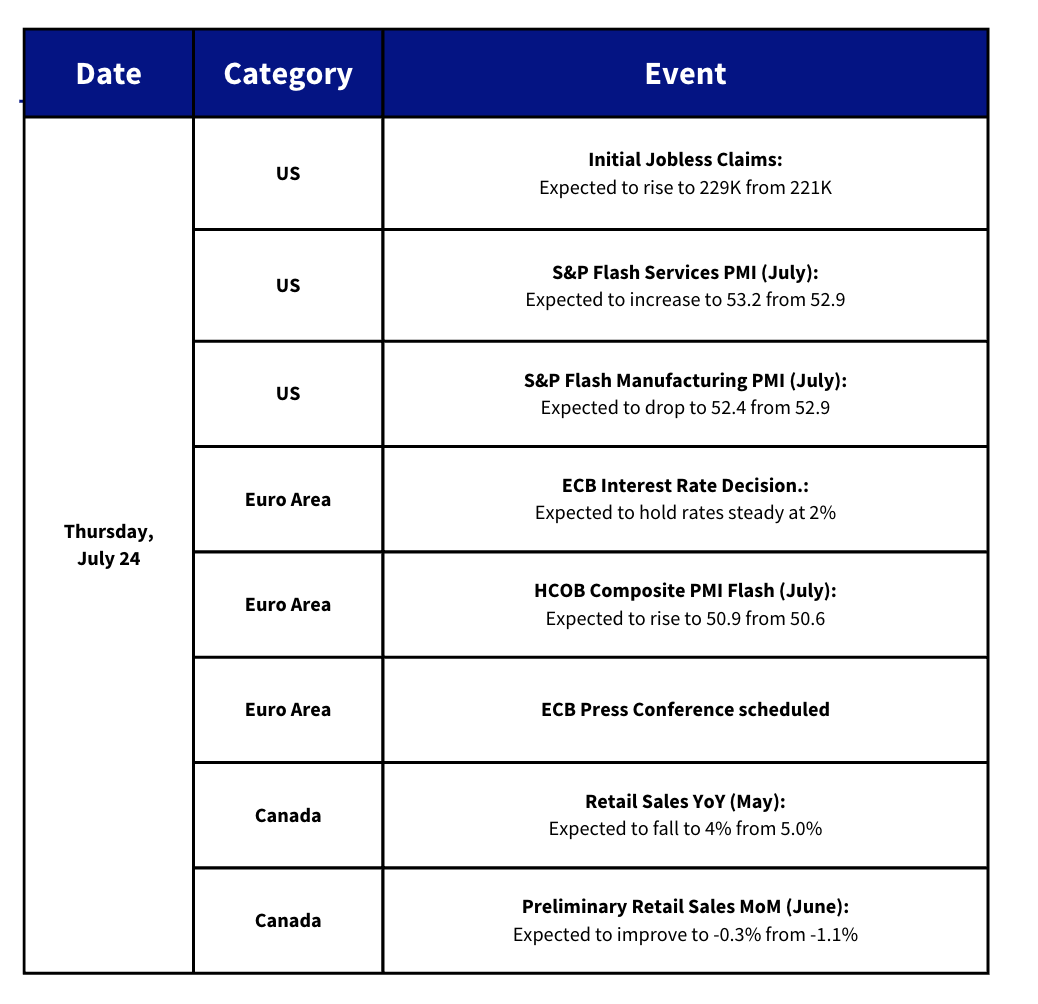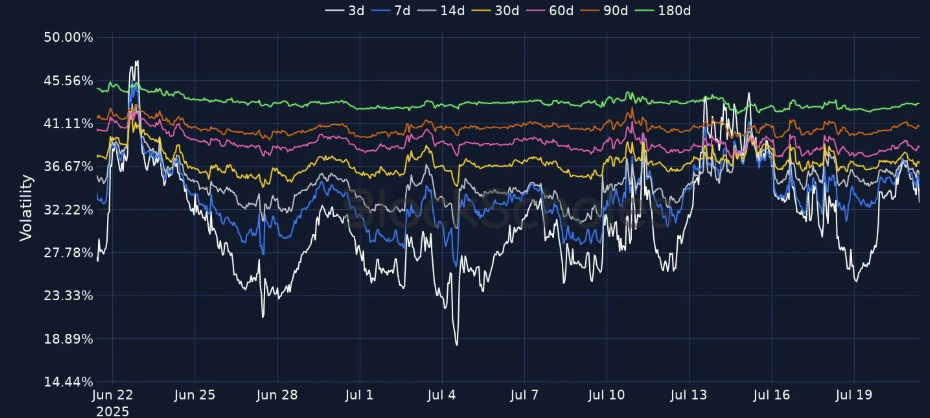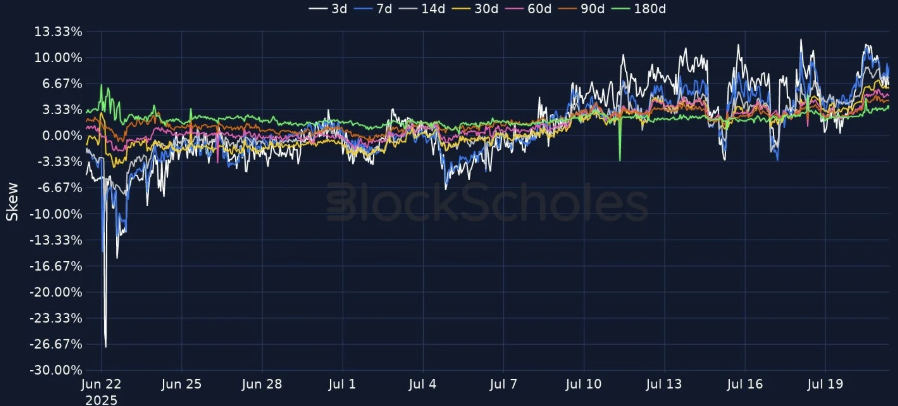Spotlight on Crypto Inflows
Crypto markets have opened this week in the green, extending on from last week’s rally that pushed the industry’s market cap above $4T for the first time. BTC is up nearly 1% over the past 24 hours, outpaced by a 3.4% increase in ETH which currently trades at $3,800 and is up 26% over the week. ETH options continue to reflect bullish sentiment with short-tenor volatility smiles skewed strongly towards call options. President Trump has hinted at a couple "big" trade deals while the EU prepares countermeasures ahead of Trump's August 1 tariff deadline. On-chain, Ethereum raised its gas limit to 39M to handle growing demand.

Daily Updates:
- Crypto markets have started the week in the green, extending on from a rally last week which saw the total market cap of the industry exceed $4T for the first time ever, amidst “Crypto Week”.
- BTC is up nearly 1% over the past 24 hours, having traded between $116K and $119K over the weekend. It has however been outperformed by the second largest cryptocurrency, Ether, which is up 3.4% in the past 24 hours and has rallied 26% over the past seven days, currently trading at $3,800 – its highest all year.
- Both have been supported by considerable inflows into their respective Spot ETF products. Bitcoin ETFs bought nearly $2.4B worth of bitcoins last week; while Spot ETH ETFs saw inflows of $2.2B.
- In options markets, ETH’s term structure of volatility remains inverted with 7-day at-the-money options carrying a volatility premium of 71% compared to the 63% implied volatility of 180-day ETH options.
- Short-tenor volatility smiles are also strongly skewed towards out-of-the-money call options – 7-day put-call skew has jumped 1.4 percentage points in the past 24 hours, bringing the 25-delta call skew ratio to 9%.
- BTC volatility smiles are also still skewed towards call options, though by a lesser 2.3% for 7-day options, with 30-day options holding the highest call-skew of 3.9%.
- Though funding rates have fallen from 0.02% and 0.018% for BTC and ETH, respectively, since Sunday evening, perpetual swap funding rates for both assets still remain positive with traders willing to pay a premium for leveraged upside exposure.
- The Japanese yen recouped some of its losses from last week as Prime Minister, Shigeru Ishiba, has vowed to stay in power even after his Liberal Democratic Party suffered a defeat in the weekend’s upper-house election. Ishuba’s party had already lost its hold over the lower house, and now means that the LDP looks likely to govern the country without a majority in at least one of the legislative chambers, something that hasn’t happened since 1955.
- JPY strengthened as much as 0.7% against the US dollar, before paring some of those gains earlier in the day.
- That marked a change from the two-week drop in the yen and the rise in government bond yields ahead of the vote, due to concerns that the Prime Minister would open the door to more spending and tax cuts.
- According to the market,‘Japan prime minister Ishiba out in 2025?’ on Polymarket, Ishiba currently has a 53% chance of remaining PM for the year.
- Elsewhere, President Trump has said he is close to announcing a couple of “big” trade deals. The European Union is set to formulate a plan for measures to respond to a possible no-deal scenario with President Trump, ahead of a looming August 1 deadline where Trump has promised a 30% tariff on EU exports.
- According to Bloomberg, the US is now reportedly looking for near-universal tariffs of at least 10% on all EU goods, with few exemptions such as on aviation, medical devices and manufacturing equipment.
- Commerce Secretary Howard Lutnick claimed that he is “confident we’ll get a deal done” when speaking on CBS’s Face the Nation program yesterday. Lutnick added “I think all these key countries will figure out it is better to open their markets to the United States of America than to pay a significant tariff”.
- The bloc has already approved potential tariffs on €21B of US goods, such as agricultural products, poultry, and motorcycles and has prepared a list of tariffs on an additional €72B of American products in response to Trump’s reciprocal tariffs and 25% automotive levies.
- Ethereum’s network gas limit has risen to 39M as over 50% of staked ETH validators signalled support for raising the gas limit to 45M, enabling automatic increases of up to 0.1% per block.
- This comes as Ethereum’s network activity has surged and raising the gas limit allows for lower transaction fees and increased transaction throughput.
- Cardano (ADA) founder Charles Hoskinson, has shared that the network’s audit report is on schedule for a mid-August release.
- This follows allegations that the Cardano ledger was manipulated in the 2021 Allegra hard fork to gain control of over $600M worth of ADA and since, the genesis keys have been used to withdraw from the ADA reserves.
This Week’s Calendar:


Charts of the Day:

Figure 1. BTC at-the-money implied volatility across selected tenors. Source: Deribit, Block Scholes

Figure 2. ETH at-the-money implied volatility across selected tenors. Source: Deribit, Block Scholes

Figure 3. BTC 25-delta put-call skew ratio across selected tenors. Source: Deribit, Block Scholes

Figure 4. ETH 25-delta put-call skew ratio across selected tenors. Source: Deribit, Block Scholes


